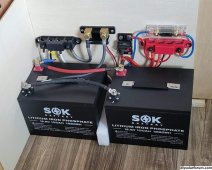New guy trying to get some clarity, I'm seeing so much conflicting information and advice I'm confused at this point as to what is reality and what isn't. To be clear I'm no electrician but know basic 12v electrical systems.
I cleaned up the trailer factory battery wiring and added two SOK 100ah lithium batteries in parallel. Trailer came with a Zamp 10A solar controller and 200w solar panel on the roof. I'm being told I should fuse between the battery positive and busbar (because of the lithium batteries) with 1/0 cable and a 250A fuse, that the 4AWG isn't big enough.
I'm confused as it’s light loads on this and there's nothing different from the factory other than organizing and adding the batteries. Just seems excessive to me.

What I did
I cleaned up the trailer factory battery wiring and added two SOK 100ah lithium batteries in parallel. Trailer came with a Zamp 10A solar controller and 200w solar panel on the roof. I'm being told I should fuse between the battery positive and busbar (because of the lithium batteries) with 1/0 cable and a 250A fuse, that the 4AWG isn't big enough.
I'm confused as it’s light loads on this and there's nothing different from the factory other than organizing and adding the batteries. Just seems excessive to me.

What I did
- Added two SOK 100ah lithium batteries in parallel (non-Bluetooth) in place of the two 6V GC2 batteries.
- Added a Victron SmartShunt.
- Added two busbars.
- Added a 30A ANL fuse for the existing external solar wall port, replaced the existing inline fuse.
- Added a 30A breaker for the roof solar to disconnect from batteries.
- Used 4AWG cable on batteries and to extend to the busbars.
- This runs the trailer 12v systems only: heater, LED lights, 12V TV sometimes, water pump, propane fridge and propane water heater.
- NO inverter installed (and don't plan on having one)
- If we need DC we either plug in to 30A shore power at campground or use our 4500w generator and plug into that.
- Batteries have never dropped below 85% overnight and charged back full by noon typically.


